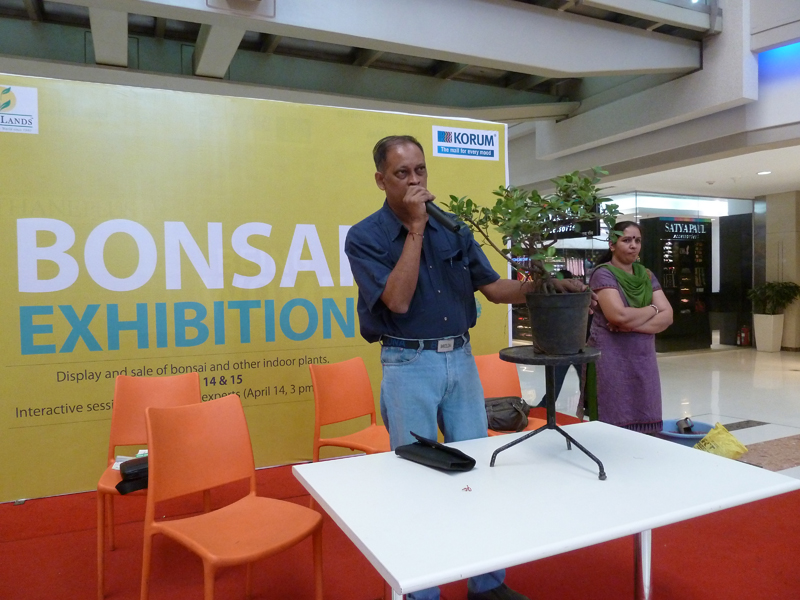BONSAI FOR THE LAYMAN
Bonsai is the art of growing ordinary plants in shallow pots by the selective application of some common principles of horticulture and techniques of gardening to bring out the natural beauty of the plants and create a look of age-old maturity in them. This scientific art and the plants cultivated through it are both termed as bonsai. The fascination of bonsai is capturing the imagination of everyone these days. It has gained popularity, as it is eminently suitable for today’s lifestyle especially of city-dwellers in their search for greenery.
For some reason, a few misconceptions about bonsai are also prevalent – that they are tied with wire to prevent their growth; or that they are given just a thimbleful of water and are generally starved to remain stunted. I would like to make it very clear at the outset that this is not true. Wire is wrapped only to alter the shape of the trunk and branches in order to conform to a natural shape. Bonsai are watered thoroughly at least once every day depending upon the climatic conditions and they are also fed nutritionally from time to time. In fact, all bonsai growers lavish a lot care on their bonsai and pamper them as if they were children or pets.
I think that misconceptions such as the above arise mainly due to the reason that the layman has a misplaced idea of cruelty to plants usually born out of seeing oddly shaped, distorted plants displayed in nurseries which do not even know what a bonsai is but are eager to cash in on its glamour. A layman is therefore most likely to be misguided and is far from being able to find correct scientific information or to actually learn the techniques of bonsai; the layman is therefore deprived of the enjoyment of nurturing and viewing bonsai. For such people, I give here some simple tips and pointers that will dispel the misconceptions and induce them to grow bonsai on their own. After all, it is man’s love for nature which leads him to discover newer ways of keeping nature nearer to him in today’s fast growing concrete jungles and disappearing greenery.
What is bonsai – Bonsai are nothing but common plants shaped to look like their bigger counterparts in nature, having all the attributes of foliage, flowers and fruits like mature trees and aesthetically looking like common trees in nature. But then, how do bonsai come into being? Let us see………
Material– The techniques of bonsai can be successfully applied to any ordinary woody plant material. There are actually no special plants for bonsai. Any ordinary plants from a number of plant species to choose from can be made into a bonsai. But those with naturally small leaf size are better and have a better chance of being convincing as a miniature tree image. Plants normally grow from seeds which can normally be found anywhere or are also propagated artificially from cuttings, air-layers amp; graft in nurseries the world over. Material for bonsai can be obtained from any of the above sources i.e., from common nursery grown plants or seedlings (both newly germinated saplings amp; thick, mature plants) or collected seedlings/plants/trees from the wilds. It is however easier for the layman to select plants from a nursery for their first attempts in bonsai as these will have an already established root-system used to growing in a small, compact container and will not involve the hardship of propagating and nurturing seeds/cuttings/grafts, etc.
Selection of plant– Choose a plant with thick woody stem but small stature. If possible the plant should have good, attractive foliage, all-round root spread, a tapering trunk amp; a profusion of branches distributed along the length of the trunk line.
Creating a bonsai
If you have ever observed the natural forms of trees around you, you may have seen that most tree species conform to some commonly recognizable genetic shape, e.g., tall straight trunks of Ashoka, rounded shapes of Mango trees, the fan-shaped appearance of Pipul trees, the flat umbrella type growth and aerial roots of the Banyan (Vad), etc. So, trees may essentially be similar but the genetic forms and shapes are different from specie to specie. Plants bought from nurseries, seedlings and dug out plants need to resemble with one of the basic shapes mentioned above. Or one may have to wait till a given plant gets such a shape or choose another plant which has such a shape. Once it is seen that the plant has one of these basic shapes its training can be started.
Training– Initially, cut short the top growth of the plant to make it look shorter and to emphasize the relative thickness of the trunk. Also, cut off the branches which look un-necessary and cluttered and are crossing each other. If necessary, change the shape of the trunk by gently wrapping it from base to apex (tip of trunk) with an ascending spiral of aluminum wire of a sufficient strength and then slowly but firmly bend it to a shape which conforms to the tree forms seen in nature. Shorten the length of the top branches so that lower branches appear bigger and longer; if necessary, wire the branches also so that their shape may be altered by gently sloping them downwards. If there is a flow to the trunk then a similar flow should be maintained in the branches also. The shape of the plant should look natural and not tortuous.
It is also possible to commence training in stages by letting the plants grow initially in bigger containers, periodically pruning them without materially altering their recognizable shape and watering amp; feeding them regularly so that over a period of time the plant becomes thicker and mature, a basic pre-requisite of a bonsai. This is a matter of choice and certainly of greater patience. After the plant resembles a mature shape either naturally or by changing it through wiring and pruning, it can be transferred to a flat ceramic of earthen container as you would plant any other plant provided you use a soil textured to be well drained. Normally, only red earth/soil are not used alone for bonsai but a quantity of organic material and draining material (such as brick crush or granular river sand) are mixed in a generous proportion to the soil. Choose any of the recognizable tree shapes mentioned above but take care not to force the plant to grow in a style which is not natural to it. Bonsai is supposed to be an aesthetic statement, not a horticultural oddity.
Maintenance– The bonsai will need only daily watering and exposure to sunlight (at least 2/4 hours a day), monthly fertilizing and pruning and re-potting after 1 to 3 years depending on its growth rate.
General– As most specie of woody plant material needs at least 2/4 hours of sunlight, it is advisable to keep bonsai outdoors only. Of course, they can occasionally be displayed in your drawing room, but care must be taken not to expose it to extended periods of air-conditioning
or excessive heat. The tree must also be checked to see if wire wrapped round the trunk/branches are not cutting into the bark and if needs be, are to be removed; wire is not applied as a fad, it is there for a purpose- the purpose of altering the shape of the part which is wired. Once the purpose is served (maybe in one season or one year or more, as necessary), the wire need not be kept on the tree. Fertilizing has to be a regular monthly feature (preferably half the recommended strength), daily watering a routine and pinching of new growth and pruning of cluttered amp; crossing branches a habit.
Please remember, nothing which is worth human effort is easy, keeping a bonsai more so as it is a commitment – just like keeping a pet. It will need constant care. But if you give it this care and attention it will definitely reward your creative instinct with green foliage, flowers and fruits, depending on the specie.
It is also my first-hand experience that bonsai are the best stress relievers and will teach you to live in harmony and peace not only with nature but also with your inner self, assets which are getting scarcer in today’s stressful lives but are so easily within our reach.

